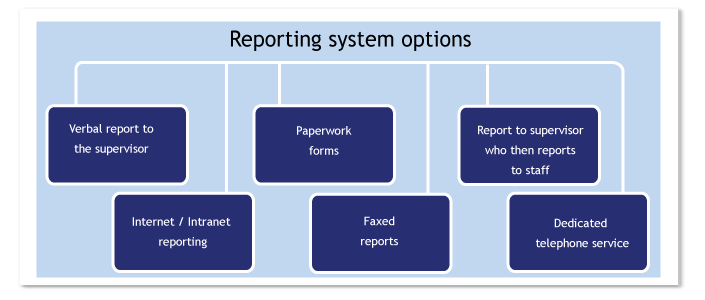| Show/Hide Hidden Text |

Weighing up the options
There are several reporting system options used in practice. Each has advantages and disadvantages in terms of efficiency and ability to positively influence outcomes. The main options are:
Verbal report to the supervisor
This is the most common form of injury reporting in use. The verbal report to supervisor meets with variable responses. The supervisor may:
Pros: This approach directly involves the two key players in RTW management – the employee and their immediate supervisor. Cons: How well this system works is dependent on the supervisor’s level of training and experience. |
Pros: Electronic reporting is efficient in terms of rapid dissemination of information. The employee may report the problem but not know who will deal with it or how it will be deal with. This disenfranchises the employee. |
Pros: Completing paperwork is an inexpensive method of injury reporting. |
Pros: Faxed reports are more rapidly received than paperwork through internal mail or post. Systems can be setup to share faxed information rapidly to speed up communication with stakeholders. |
Report to supervisor, who then reports to other staff
Once the supervisor receives a verbal report of injury they notify other staff who coordinate the process. This common approach has variable systems in place, such as an email, faxed report, written incident report, and variable timing of handover of reporting information. Pros: This approach allows for the immediate reporting of injuries. |
This approach provides an experienced case manager to take an initial injury report over the phone, directly from the employee or the employee’s supervisor. The case manager completes relevant paperwork during the call and addresses the initial issues of treatment and work duties. Pros: Supervisors and employees do not have to fill in forms, which makes the system easier to use. |
Summary of pros and cons of each system
The table below summarises the pros and cons of each system. Pros and cons of reporting systems (modified from Day of Injury study^)
*dependant on training and competence of supervisor A dedicated telephone reporting system is thus the best system for ‘covering all bases.’ |
An overseas study of reporting systems* found that day one reporting to an experienced case manager – in this case a nurse – resulted in:
| • | A decline in formal claims; |
| • | A reduction in delayed reports; |
| • | Improved employee satisfaction; |
| • | A reduction in disputed claims; and |
| • | A significant reduction in overall claims costs. |
*PERI Day of Injury Study: “Controlling the workers’ comp line of scrimmage.” Public Entity Risk Institute (PERI), 2005